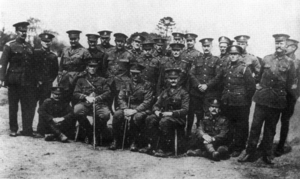King Edward's Horse facts for kids
Quick facts for kids King Edward's Horse |
|
|---|---|
| Active | 1901–1924 |
| Country | |
| Branch | |
| Type | Cavalry |
| Role | Yeomanry |
| Size | Regiment |
| Garrison/HQ | Duke of York's Headquarters |
| Motto(s) | Regi adsumus Coloni (Colonials venture for the King) |
| Engagements | First World War |
King Edward's Horse was a special cavalry regiment in the British Army. It was formed in 1901 and fought in the First World War. Its full name was The King's Overseas Dominions Regiment.
Contents
The Start of King Edward's Horse
This regiment began in November 1901. It was first called the 4th County of London Imperial Yeomanry (King's Colonials). The Prince of Wales, who later became King George V, was its honorary leader.
The regiment was made up of volunteers from different parts of the British Empire. These soldiers lived in London. There were squadrons (small groups of cavalry) from:
- Asia (British Asian Squadron)
- Canada (British American Squadron)
- Australia and New Zealand (Australasian Squadron)
- South Africa and Rhodesia (British African Squadron)
Later, a separate New Zealand squadron was formed. The Australasian squadron then became just Australian. This regiment did not fight in the South African War.
Name Changes Over Time
The regiment's name changed a few times:
- In 1905, it became The King's Colonials, Imperial Yeomanry.
- In 1908, it joined the Yeomanry in the Territorial Force. This was a group of volunteer soldiers.
- By 1909, the squadrons no longer had specific country names.
- In 1910, after King Edward VII died, the regiment was renamed King Edward's Horse (The King's Overseas Dominions Regiment).
- In 1913, it became part of the Special Reserve. This meant it was no longer considered Yeomanry.
- When a second regiment, the 2nd King Edward's Horse, was formed in 1914, this original regiment became known as 1st King Edward's Horse.
Fighting in the First World War
When the First World War started in 1914, the regiment gathered at the Duke of York's Headquarters in Chelsea, London. They stayed in London until April 1915.
After that, the regiment's four squadrons were split up. Each squadron went to the Western Front with different army divisions. The Western Front was a major battle area in France and Belgium.
Reunion and Later Service
The squadrons finally came back together in June 1916. The regiment then served as "corps troops," which means they supported larger army groups.
In December 1917, the regiment moved to Italy. They returned to France in March 1918 and fought until the war ended. Some stories say that the very last British soldier to be injured in the war was from C squadron of King Edward's Horse.
During the war, Langley Park House was used as a hospital. It cared for officers from the 2nd King Edward's Horse regiment.
Regimental Uniforms
When King Edward's Horse was formed in 1901, its soldiers wore a special uniform. It was made of khaki fabric. The collar, cuffs, and breeches (riding pants) had narrow scarlet (bright red) stripes.
Unique Hat Badges
Their hat was wide-brimmed and made of khaki felt. It had a scarlet feather plume. What was really unusual was that they wore three badges on their hat! There were two regimental badges and one squadron badge. The squadron badge showed where the soldier was from:
- An elephant for Asian soldiers
- A beaver for Canadians
- A kangaroo for Australians
- An ostrich for South Africans
- A fern-leaf for New Zealanders
After 1904, new uniform features were added. This included a large, drooping plume of black and green feathers. It was inspired by the Italian Bersaglieri soldiers. Until the First World War, their dress uniform remained khaki with red braiding and stripes. For training and active duty, they wore the plain khaki field uniform of the British Army. This uniform was used more and more until the regiment was disbanded in 1924.
The King's Colonials Lodge
The King Edward's Horse regiment was officially disbanded in March 1924. The group for former soldiers also stopped existing. However, a special part of the regiment continued on.
In 1909, the regiment had created a masonic lodge called the King's Colonials Lodge No 3386 in London. A masonic lodge is like a club for people who share certain values and traditions.
As fewer and fewer former soldiers of the regiment were still alive, the Lodge opened its membership to anyone interested. They also took on all the traditions of the regiment. The leader of the Lodge, called the Worshipful Master, is allowed to wear the regimental tie.
The Lodge is still active today. It continues to keep the regiment's traditions alive. They also look after the graves of former soldiers and place wreaths at the regiment's memorials in London and France.
Battle Honours
Battle honours are special awards given to military units for their bravery in battles. Here are some of the battles King Edward's Horse was recognized for during the First World War:
- Loos
- Ypres 1917
- Pilckem
- Cambrai 1917
- Lys
- Estaires
- Hazebrouck
- Pursuit to Mons
- France and Flanders, 1915-16 and 1918
- Italy 1917-18
See also
- County of London Yeomanry
- 2nd King Edward's Horse


